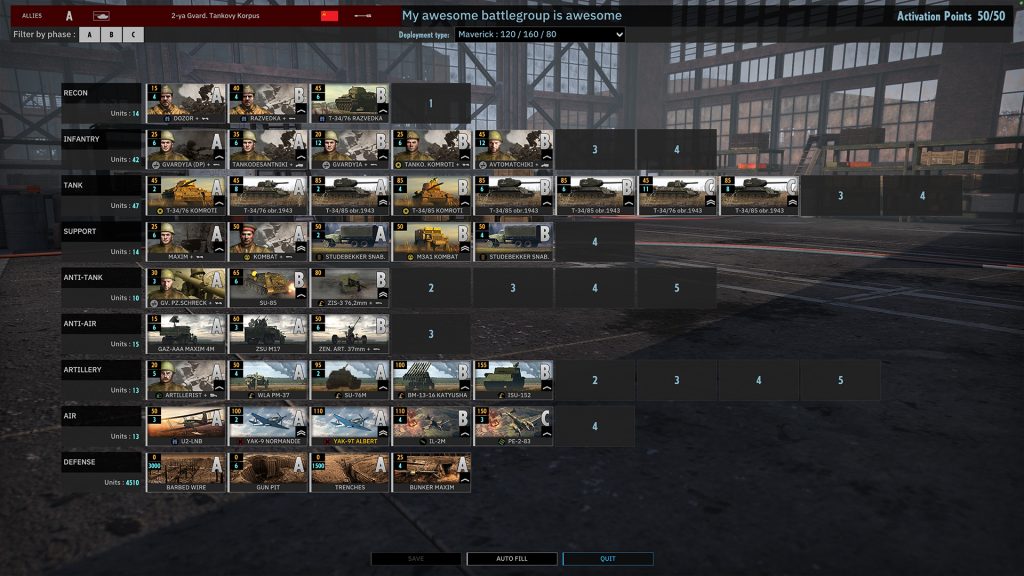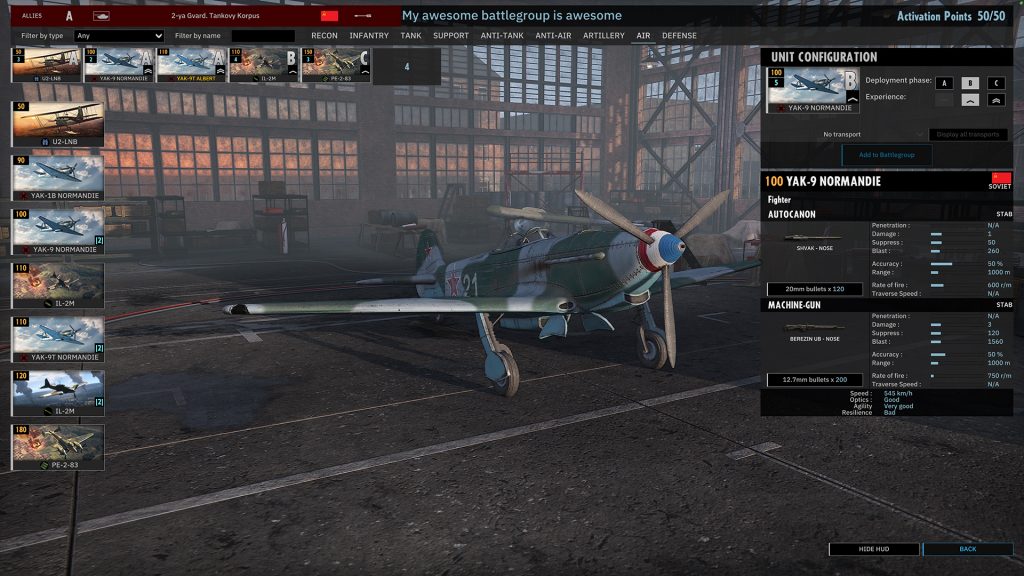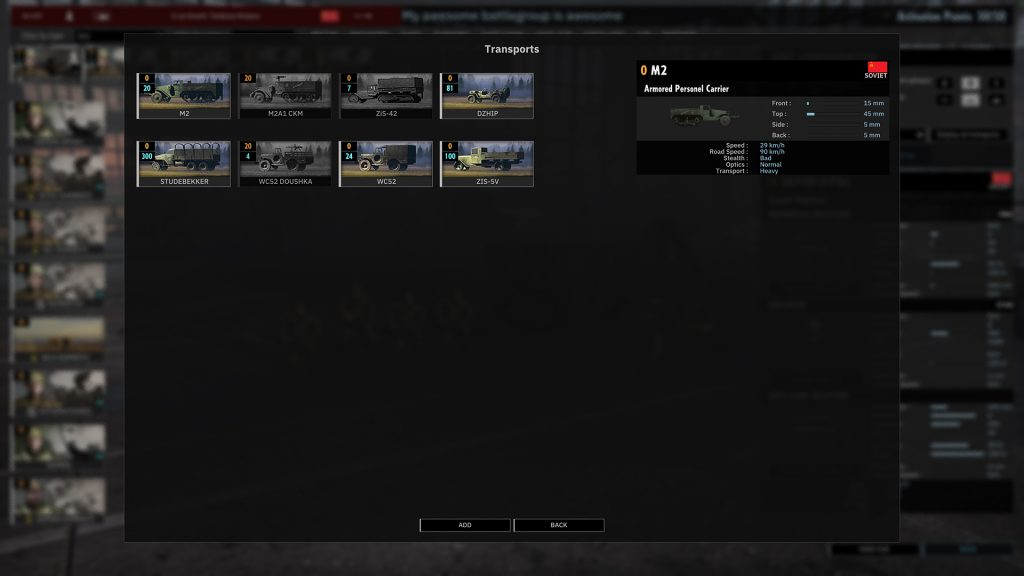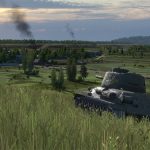Hello all! Welcome back to a brand-new dev diary for Steel Division 2. We like to keep on bringing you the good stuff, so in today’s rather big entry we’ll be delving deep into the new Deck Builder.
The Deck Builder is still being worked on, so disregard any typos, glitches or strange language. This will all be fixed at launch.
The new Deck Builder
We are proud to present the new Deck Builder, where you will create and customize your own Battlegroups to be used in skirmish matches (solo, cooperative, and multiplayer). Compared to Steel Division: Normandy 44, we have vastly increased the freedom players have in creating their own Battlegroups: you decide your own economy rate; unit cards are no longer locked to a phase; in the new Deck Builder you decide how and when to bring a unit to the battle. Keep on reading to find out more.
Each Battlegroup is created from a parent division, which comes with strengths and weaknesses, as well as the number of open card slots per unit category. In Steel Division 2, there will be nine Axis and nine Soviet parent divisions to choose from (not taking into account the four Allied and four Axis divisions from Normandy 44 from the Back to War pack).
There will be even more divisions to choose from with the History Pass that offers access to DLC’s planned to release during the year after the game officially launches on April 4th.
Our main objective was to give the player the freedom to create their own playstyle, as they see fit, without having to resort to fixed economies, phases or experience levels. Of course, Steel Division 2 will ship with the option to autofill your Battlegroups, so you can jump in and play straight away.
Creating a Battlegroup
When you create a Battlegroup, you need to choose which parent division you want to work from. The division you will select will determine the number of open card slots available per category (Tanks, Artillery, Defenses, Air, etc.). It also gives you a number of activation points. Each card slot requires activation points to unlock, the cost of which rises the more slots you want to use in a particular category. Each Battlegroup comes with 50 activation points, but there will be divisions that might come with more (or less).
Next to the division’s name, you will see the emblem or coat of arms, the type, the nickname or official title if it has one, as well as the Division Rating. The rating ranges from A to C and gives an indication of the relative power of a division. Essentially, A’s are top tier multiplayer divisions, while B’s and C’s might be a bit trickier and better suited for other modes.
The User Interface
The first thing you will notice entering the Deck Builder are the rows and columns of open slots where you will place your unit cards. You can use the filter function to see the cards per phase. Once you select a card, the user interface will show you the different options available for the category, as well as all the details of the unit card selected, their firepower and other detailed statistics, the number of units a card brings, their in-game tactical economy cost, and much more. You can also filter by type or name.
Selecting your Tactical Economy Rate
Gone are the days that each division came with a fixed economy rate for each phase. In Steel Division 2, for each Battlegroup, you choose your own tactical economy rate from four different presets. This will determine the points you will gain per minute and per phase during a game.
For instance, Juggernaut will be an economy type that heavily focuses on income during the late game. Maverick, on the other hand, will see a higher tick rate in Phase B. There will also be an aggressive early game preset and a balanced economy rate one. Deciding on the right tactical rate will be an important decision in creating a viable Battlegroup!
Unit Cards and Veterancy
Another way we expanded the player’s freedom in customizing their own Battlegroup is giving the player the freedom in deciding in which phase they want to bring a unit card. Depending on which phase you have placed a unit card in your deck, you can now determine how many individual troops or tanks you will bring to a battle. We feel this is a major upgrade compared to the previous game, which used a fixed phase-system. Not only that, the number of troops per card will differ depending on their veterancy level, which is also an option you can choose when adding a card to your deck. There are three experience levels: Rookie, Veteran, and the mighty Elite.
Let’s take a look at an example: the ubiquitous T-34 tank. You select the parent division (say the renowned Soviet 2nd Tank Corps) which gives you a large number of card slots in the Tank category. A unit card of T-34’s with Rookie veterancy in Phase A will bring 4 tanks. In Phase B, with the same veterancy level, this number will rise to 8 tanks. And in Phase C, you will get a whooping 16 T-34’s. There is a trade-off if you want to bring more experienced tanks, though. They are better fighters, but more expensive as well. In our case, the second veterancy level, Veteran, will give you 3 tanks in Phase A, 6 tanks in Phase B, and 12 tanks in Phase C. Say you want your most experienced troops, Elite level, you can only bring 2 T-34’s in Phase A, 4 tanks in Phase B, and 6 tanks in Phase C.
As a side-note, some very specific unit cards will come with a higher default veterancy level; this indicates that these are battle-hardened troops. The vast majority of the unit cards will come without any phase or experience level limitations.
Transports and Authenticity
The same flexibility has been extended to your infantry unit cards. In Steel Division 2, you can select the transport your infantry units will use when on the battlefield. Choose a lend-lease Studebaker, or go for a vehicle with a mounted machine gun. The more powerful the transport, the more expensive your unit will be.
There will be a maximum number of transport vehicles. For instance, an average Battlegroup will have a pool of various types of trucks, the standard variant amounting to 300 trucks in total. You will be able to get all your infantry motorized, but the more powerful versions carrying weapons, such as half-tracks, will be limited in availability. This is authentic if you look at the real-life availability of equipment for German and Russian formations of that era. We have extended this authenticity to all the equipment and number of vehicles in your deck; while not exact, the total number of tanks, for instance, will be pretty close to what was fielded in the summer of 1944.
In conclusion
We are very excited about our new Deck Builder, and we think that you will come to love it as much as we do. It gives more freedom and more detail to our players, deepens the complexity while at the same time being as authentic as possible. Just the way we like it. Let us know what you think!
As always, stay tuned for the new dev diary which will come next week. Don’t forget to check out the Steel Division 2 newsletter, pre-order the game on steam, and visit our pre-order store.






No Comments